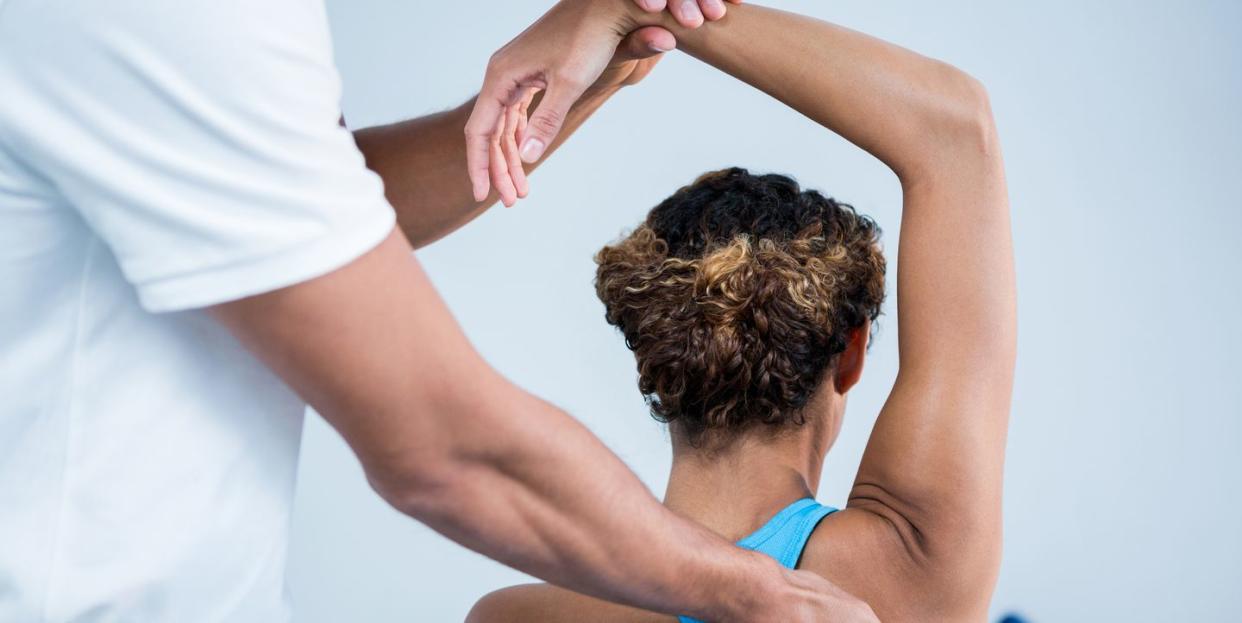Muscle Testing May Sound Intriguing, But Experts Are Skeptical Over The Practice

For fitness-minded folks, muscle testing can sound pretty intriguing. But it turns out that it has little to do with fitness...or even muscles.
On a basic level, muscle testing looks at a muscle and then determines that something may be off with an entirely different body part. It’s usually an internal versus external thing, like you have an issue with your calf muscle, which signals some kind of an issue <gestures broadly> with an internal organ. (More on that in a second.)
Muscle testing doesn’t diagnose you with a specific issue, but fans say it can help you pinpoint areas of your health that you need to work on.
It’s important to state this up front: Muscle testing isn’t considered the most scientific process out there. Meaning, there aren’t really any good studies to support its use and because of that it’s not something you’ll find a lot of doctors practicing.
Still, there’s growing interest in muscle testing and it’s totally understandable to have questions about it, including whether you can try this at home on yourself.
Here’s the deal with muscle testing and how it works, plus why it’s still important to see a medical professional if you suspect something is off with your health.
Meet the experts: Steven K. Malin, PhD, is an associate professor in the Department of Kinesiology at Rutgers Robert Wood Johnson Medical School in New Brunswick, New Jersey. Zach Johnston, DPT, is a physical therapist at Providence Saint John’s Health Center’s Performance Therapy in Santa Monica, California.
What is muscle testing?
Muscle testing, also known as applied kinesiology, was founded by a Michigan chiropractor named George J. Goodheart, Jr. In 1964, he said he fixed a patient’s chronic winged scapula (muscles in the back that were weak or paralyzed) by pressing on nodules near the ribcage.
The practice grew from there, with small studies trying to link things like whether someone was given fructose or glucose to the strength of their arms.
“It is often viewed as an alternative medical practice to diagnose neurologic, structural, chemical, or mental concerns," says Steven K. Malin, PhD, associate professor in the Department of Kinesiology at Rutgers Robert Wood Johnson Medical School in New Brunswick, New Jersey.
Treatments can involve specific joint manipulation or mobilization, various myofascial therapies, cranial techniques, acupuncture, dietary changes, counseling skills, and evaluating environmental irritants, according to the International College of Applied Kinesiology.
But again, there isn’t robust research on the method, period, to back this up—but there is limited data to suggest it doesn't work. One small study, for example, concluded that applied kinesiology “is not reliable” when it comes to verifying if someone has a wasp venom allergy.
How is muscle testing done?
Muscle testing is a little vague, and some of it is left open to interpretation. “Most times today, when muscle testing is being discussed, it is being referenced towards chiropractors, nutritionists—not to be confused with registered dietitians—naturopathic doctors, and massage or physical therapists,” Malin says.
“In general though, the medical community do not use these approaches as the studies have been considered to lack standardization in order to be compared to norms,” he continues. “As such, the tests are considered to have low usability or reliability in regards to diagnosis for health decisions to be garnered.”
Still curious? There are different types of muscle testing, including insertion treatment (like the winged scapula example), along with the vertebral challenge method (where pressure is applied to the spine), therapy localization technique (where the patient places a hand that is not being tested on the skin over an area of the body that's thought to be struggling), and manual muscle testing.
Manual muscle testing “evaluates the function and strength of individual muscles or muscle groups in relation to the forces of gravity and manual resistance,” explains Zach Johnston, DPT, a physical therapist at Providence Saint John’s Health Center’s Performance Therapy in Santa Monica, California. “A clinician will assess if a muscle is strong or weak via manual pressure and ask the patient to resist that pressure. Manual muscle testing is rated on a scale from zero to five.”
But the tests are “limited in that they sometimes are used to assess nutritional needs or presence of mental/emotional stress,” Malin says, noting that there’s not really research to support that this works.
Can you muscle test yourself?
Yes-ish. You could try muscle testing at home, but it's not likely to tell you much. “While there isn’t data suggesting harm is directly caused by muscle testing, doing it at home is not advised,” Malin says. “This is mainly due to issues surrounding muscle testing and lack of clear research supporting standardization and protocol.”
Instead, if you’re concerned that you might have weak muscles (or have another underlying health issue), Malin recommends seeing your doctor. “Recommendations on seeking proper care, which might include physical therapy and/or neurologists, could help correct such muscle weakness and restore function,” Malin says.
Johnston agrees that physical therapy is a preferred way of approaching weak muscles. “Physical therapy is a great option to have a healthcare professional create a plan of care that can establish a program that will work on specific muscles and/or muscle groups that need strengthening while implementing optimal exercises and interventions to produce those results,” he says.
Basically, if you’re concerned that you’re experiencing some muscle weakness, it’s really best to get it checked out by a licensed medical provider. And, if you think you have an undiagnosed health condition, see your primary care physician.
You Might Also Like
